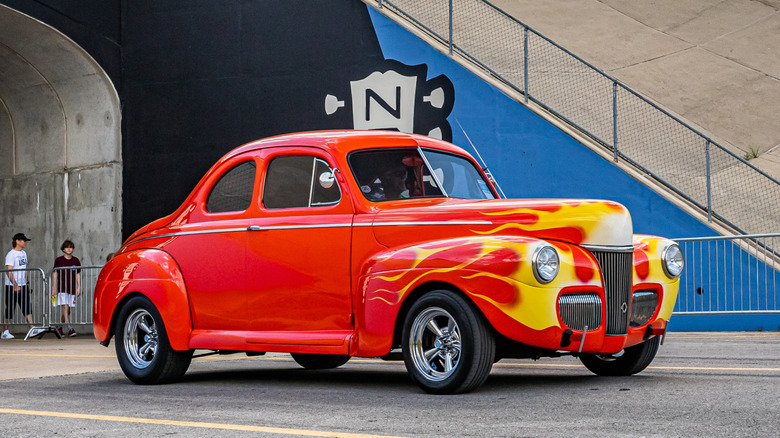What Are Ford Fat Fenders And Which Years Were They Made?
Ford Motor Company forever changed the landscape of the automobile industry when it released its first production car, the iconic Model T, in 1908. While that innovative vehicle continues to rank among Ford's best-selling offerings and is undoubtedly the most popular car of its era, Ford's design concepts have continued to evolve in the decades since The Model T. So much so, the Fords of today legitimately look like the stuff of science fiction by comparison.
Still, some Ford diehards might argue the company really came into its own on the design front in the 1930s and 1940s, right around the time the classy "fat fender" builds began rolling off the production line. If you're unfamiliar with the fat fender concept, it's a term applied to cars and trucks from the period designed to feature bulbous, oversized fenders covering their tires, particularly those at the front end of the vehicle. But if you're still having trouble envisioning the look, the 1946 Ford Coupe driven by Biff Tannen in "Back to the Future" is a solid example of the fat fender style.
While fat fenders were a trend with virtually every automaker of the day, Ford arguably leaned into the expressionistic design feature more than most. Ford stayed in the fat fender game for almost a decade and a half, keeping the style in vogue between the 1935 and 1948 model years. However, the style largely disappeared in 1949, with automakers switching to sleeker designs and integrated fenders.
Fat fender Fords have become a hit with hot-rodders and restorers
Though Ford abandoned the fat fender model along with most automakers at the end of the 1940s, the cars have remained popular with collectors, restorers, and customizers over the years. Though the beefy builds weren't exactly a hit with hot-rodders of the era (many of whom preferred slimmer, stripped-down makes), these days, fat fender Fords and their sometimes menacingly muscled-up front ends are starting to gain popularity with the speed-seeking set.
There are a few good reasons for that, and perhaps the biggest is that so many fat fender vehicles were manufactured by Ford and other automakers during their heyday. As a result, the builds can often be found for sale on the secondhand market at a relatively reasonable price, thus making them ideal for budget-minded restoration projects. The same is likely true for some of the vintage parts you might need to get your fat fender resto on the road. Some savvy customizers also point out that the oversized fenders can actually save you a few bucks in the restoration phase, as they totally cover a vehicle's suspension and chassis components, leaving you little reason to pay extra for flashy high-priced parts there.
Perhaps more importantly, we'll note that in the 1930s and 1940s, speed was not the goal for many fat fender models from Ford and other manufacturers, with a smooth ride and the overall comfort of drivers and passengers taking precedence. Given that fact, it's generally believed that a restored fat fender build will still deliver a comfy ride for one and all, and that should remain true even if you significantly upgrade the vehicle's under-the-hood muscle.

